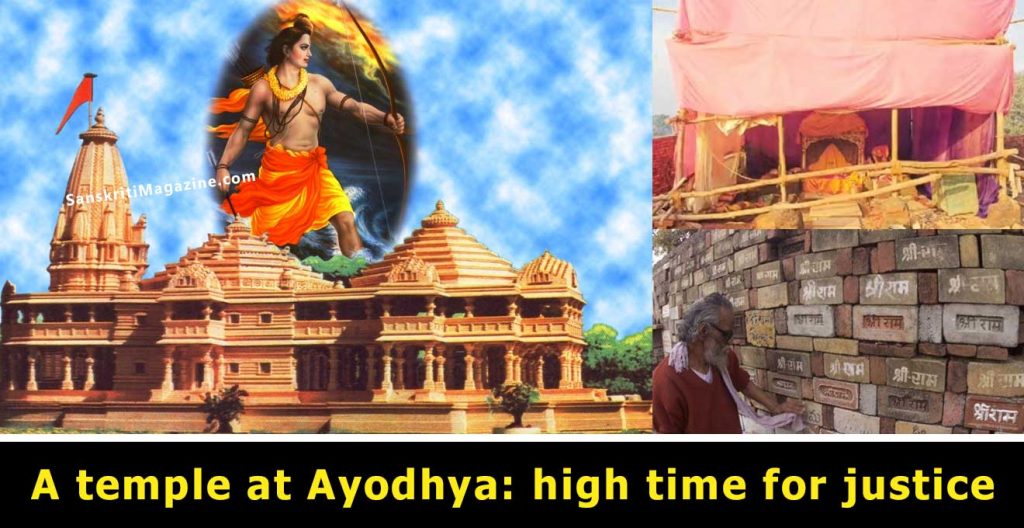~ Dr Gopa Nayak
The current debate over the Ayodhya site triggered by the Supreme Court’s order to have an amicable out-of-court settlement erupts age old controversies. As I delved deep into the controversy, my background as a researcher prompted me to read a book by Kunal Kishore with the title ‘Ayodhya revisited’. Drawing on historical and scriptural evidence vividly documented in the seven hundred plus pages, this book unambiguously concludes that Ayodhya is the sacred site originally dedicated to a temple of Rama, the revered lord of the Hindus.
Although the book painstakingly relies on quotes from religious texts and seers, accounts of travelers, essays of historians, verdicts of judges and any available source on Ayodhya ramjanambhumi controversy as it is famously known, the main argument is never lost. The book has clear chapters based on analogies that are complex and arguments that are coherent around the main idea that Ayodhya was the home of Lord Ram and the site of a temple where Hindus worshipped. Taking the different chapters into account one can get a glimpse of the changes that have taken place in the temple of Ram, which was subsequently taken over by others culminating in its present controversial status.
That Ayodhya was never an abandoned city is a recurrent theme in the book ‘Revisiting Ayodhya’. The author has argued rationally that Ayodhya was first and foremost the birthplace of the Rama, the ancient Hindu God whose story has been preserved in the puranas and folklores in equal measures. The sacredness of the site in and around the temple at Ayodhya is beyond question. Whether it was made sacred by the construction of the temple or whether the Hindu temple was constructed on a scared place can be open for debates and discussion. However, if we go by the history of other Hindu temples there is ample evidence to suggest that sites of Hindu temples were always chosen at sacred sites.
The book makes a claim on the basis of historical evidence that the temple of Rama was present at the site in the 12th century. The author, Kunal Kishore, cites his personal involvement with reference to a stone inscription recovered from the debris of the disputed structure. This inscription was examined by a team from Times of India and UNESCO who worked in collaboration and came to the conclusion on the 1st of Sept 2001, that there is conclusive proof of a Rama temple at the site in the 12th century or even earlier. In the ASI report in 2003, the evidence of a temple has been proved.
The book also provides evidence that in the year 1660 A.D., monuments and temples in and around Ayodhya were demolished and mosques were built by Fedai Khan at the behest of Aurangzeb. Francis Buchanan (1813-14) made a survey and the demolition of the Ayodhya temple was attributed to Aurangzeb. If a sequential account provided in the book is taken as a point of reference, the next big event associated with the temple is that of the taking over by the Ramanandi sadhus. Amber’s Raja Sawai Jay Singh held a conference in AD 1718, where the Vaishnavs particularly Ramanandis took over the responsibility of restoring Vaishnav sites from the Shaivs and the Muslims.
This led to the Bairagi Vaishnavas getting back the Ayodhya temple at the middle of 18th century. There is a very interesting reference to the patronage of the Shia Nawabs for the temple which was triggered when a Shia Muslim Nawab Safdar Jung was cured of a severe illness because of the prayer by a Ramanandi Sadhu at this temple in the year 1740 to 50 AD. This so-called boon perhaps turned out to be a curse for the temple. After the event the site of the temple started gaining fame as a sacred site where even Muslims can get blessings. This led to the site being frequented by Muslims. Hindu being a very generous group of people did not mind sharing their place of worship with Muslims. It was, after all, the birthplace of their lord, Rama. The more people visited the place, the more the place was getting acclaim. Then slowly and steadily this place became the place where Muslims started offering their prayers.
This could have prompted the patronage of the Nawabs as historical records show that the temple and accommodation for the sadhus were built at the site. Bairagi Nimrohi Akhada was allowed to construct the Hanuman temple with patronage from the Nawabs of Awadh. After the capital of Awadh was shifted to Faizabad the Muslims left and the temples were taken over by the Hindu Bairagis. Trata ka Thakur temple was rebuilt during this time. During the liberal rule of first four Awadh Nawabs, the Ramanandi Bairagi sadhus succeeded in retrieving most of the lost sites associated with the life of Rama and constructing new grand temples.
However, there are descriptions which show that no Muslims were allowed within the walls of the temple till 1854 although both used to worship at the place. Joseph TIeffenthaler as well as Carnegy’s book published in 1870, mention that both Hindus and Muslims offered prayers at the site till the 1858. After the proclamation of Queen Victoria in 1858, Ayodhya came under the direct rule of the British government. The British government’s decision to stop Hindus from performing rituals at the site fueled animosity and resulted in the forcible possession of the shrine in 1858 AD by Nihang Singh along with 25 Sikhs. These people wrote Ram Ram in black charcoal all over the temple. This is, in short, the long and checkered history of Ayodhya described in the book.
Also watch – Archaeological evidence of Ram Mandir’s
existence under Babri Masjid
Given the evidence highlighted in the book the argument is undeniably strong that the temple was originally built on the birthplace of Rama on the basis of religious sentiment. The temple has borne the abuses of the rich and the mighty who did not share the sentiments of the millions. However, the fact remains that the temple remains in the psyche of these millions through the stories read, heard and preserved as their rich heritage. Poverty and atrocity have not been able to wipe off the sentiment of that heritage. This sentiment was highlighted in the recent Supreme Court order which makes an appeal for an amicable settlement. The demand for a temple at the place which is believed to be the birthplace of Rama is based not only on scriptural, archeological and historical evidence but also on faith and belief which cannot have legal status. The legal can only be fought by taking into account the ethical and the emotional.
The ethical and emotional rationale for a temple at Ayodhya is based on the undying faith of the Hindus that Lord Rama was born in this holy site. Hindus have been curbing their desire for a temple at Ayodhya perhaps on the basis of one of the main tenets of Hinduism which is acceptance. However, every devout Hindu is perhaps silently praying for a temple at the sacred site where the Lord was born. Now Hindus feels that it is time to rationally argue that the site of a temple is not an ordinary land dispute. It is a case of how might destroyed the religious sentiments of thousands of people for hundreds of years. It is time to restore the faith of millions in this country. It is time to assuage millions of believers that their sentiments count. That they are now free to get back their heritage wrongfully taken away from them.
 If anything building a temple at the site is the only solution to the disputed land and by doing so Hindus can perhaps forget the atrocities done to them and to the birthplace of their lord Rama, the noble and pious ruler of this land.
If anything building a temple at the site is the only solution to the disputed land and by doing so Hindus can perhaps forget the atrocities done to them and to the birthplace of their lord Rama, the noble and pious ruler of this land.
Dr Gopa Nayak is an academician, a researcher and a writer. She has a DPhil from the University of Oxford and is currently serving as Director of English Language Centre at O.P. Jindal Global University.










